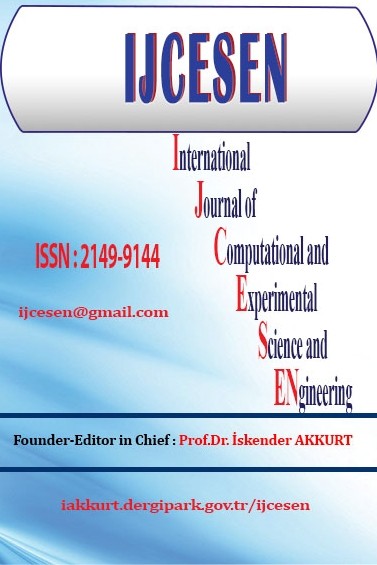Evaluation of Ergonomic Conditions using Fuzzy Logic in a Metal Processing Plant
Evaluation of Ergonomic Conditions using Fuzzy Logic in a Metal Processing Plant
Ergonomic conditions of workplace settings is important for the performance of companies. Especially in the manufacturing industry, the employees are required to have convenient workplace conditions. If this is not the case, it is most likely to have a decrease in work efficiency, increase in workload, and negative impacts on employee health. In this study, we evaluate two ergonomic conditions, illumination and noise level, in different departments of a metal processing plant, to find the initial department to work on the improvement of ergonomic conditions. The evaluation of ergonomic conditions is done through a fuzzification process. The quantitative measurement results of illumination and noise level are fuzzified by Mamdani method. The fuzzified measurement values are scored with respect to specified interval lengths. As a result of this scoring process, ergonomically the worst conditioned department is found to start the improvement process.
Keywords:
Fuzzy Logic Ergonomy, Noise Level, Illumination,
___
- [1] Zadeh L.A., (1965). Fuzzy sets. Information and Control. 8(3):338–353. DOI: 10.1016/S0019-9958(65)90241-X
- [2] Li D. F. and J.-B-. Yang. (2004). Fuzzy linear programming technique for multiattribute group decision making in fuzzy environments. Inf. Sci. (Ny). 158:263–275. DOI: 10.1016/j.ins.2003.08.007
- [3] Çalışkan M. and F. Fındık. (2012). Malzeme, Ergonomi Ve Biyomekanik İlişkisi. Sakarya Üniv. Fen Bilim. Enstitüsü Derg. 16(3):273–282. DOI: 10.16984/saufbed.08867
- [4] Coşkun M.B., H. Sağıroğlu, and N. Erginel, (2015) İş İstasyonlarının Ergonomik Riskinin Niosh Yöntemi İle Belirlenmesi. Mühendislik Bilim. ve Tasarım Derg., 3(3):365–370.
- [5] Alkan E. and M. A. Ilgın, (2018), Bir Elektronik Firmasının Montaj Hatlarının Ergonomik Analizi. Ömer Halisdemir Üniversitesi Mühendislik Bilim. Derg., 7(1):149–158. DOI: 10.28948/ngumuh.386385
- [6] Can G. F., K. D. Atalay, and E. Eraslan, (2015). Working Posture Analysis in Fuzzy Environment and Ergonomic Work Station Design Recommendations. Journal of the Faculty of Engineering and Architecture of Gazi University 30:451-460
- [7] Güner M., A.. İlleez, and C. Ünal, (2009), Evaluation of Plant's Physical Conditions Using Fuzzy Logic: An Apparel Industry Case Study, Tekst. ve Konfeksiyon, 19(3):206–211.
- [8] Başbakanlık Mevzuatı Geliştirme ve Yayın Genel Müdürlüğü. (Accessed: 29-Jan-2021) https://www.resmigazete.gov.tr/eskiler/2013/07/20130728-11.htm
- [9] Güner M. A., A. A. İlleez, Konfeksiyon İşletmeleri Kalite Kontrol Departmanlarındaki Aydınlatma Seviyeleri, TMOBB Elekrik Mühendisleri Odası. https://www.emo.org.tr/ekler/051430a15d3d44d_ek.pdf
- [10] Özkan M., (2003), Bulanık Hedef Programlama. Ekin Kitabevi
- [11] Aluclu I., A. Dalgic and Z.F. Toprak, (2008), A Fuzzy Logic-based Model for Noise Control at Industrial Workplaces, Applied Ergonomics, 39:368-378. DOI: 10.1016/j.apergo.2007.08.005
- [12] Taqizade S., H. Eskandari, I. Alimohammadi and F. Jaderi, (2014), A fuzzy expert system for selection of an effective method for noise reduction in a petrochemical complex, Noise Control Engineering Journal, 62:344-353.
- [13] Mamdani E.H. and S. Assilian, (1975), An experiment in linguistic synthesis with a fuzzy logic controller, International Journal of Man-Machine Studies, 7(1):1-13. DOI: 10.1016/S0020-7373(75)80002-2
- [14] Zhou H. and H. Ying, (2013), A method for deriving the analytical structure of a broad class of typical interval type-2 Mamdani fuzzy controllers, IEEE Trans. Fuzzy Syst., 21(3):447–458. DOI: 10.1109/TFUZZ.2012.2226891
- [15] Sanchez-Torrubia M.G., C. Torres-Blanc, and S. Krishnankutty, (2006), Analyzing and applying computer algebraic systems to engineering education: WSEAS Transactions on Advances in Engineering Education, 3:977-983.
- Başlangıç: 2015
- Yayıncı: Prof.Dr. İskender Akkurt
Sayıdaki Diğer Makaleler
Simulation of Neutrons Shielding Properties for Some Medical Materials
Faez WAHEED, Meltem İMAMOĞLU, Nurdan KARPUZ, Hüseyin OVALIOĞLU
Modeling of a Tandem Solar Cell Structure Based on CZTS and CZTSe Absorber Materials
Mohammed Flayyih HASAN, Merdin DANIŞMAZ, Faez WAHEED
Gökhan KESKİN, Abdulkadir ÇAKMAK
Evaluation of Ergonomic Conditions using Fuzzy Logic in a Metal Processing Plant
